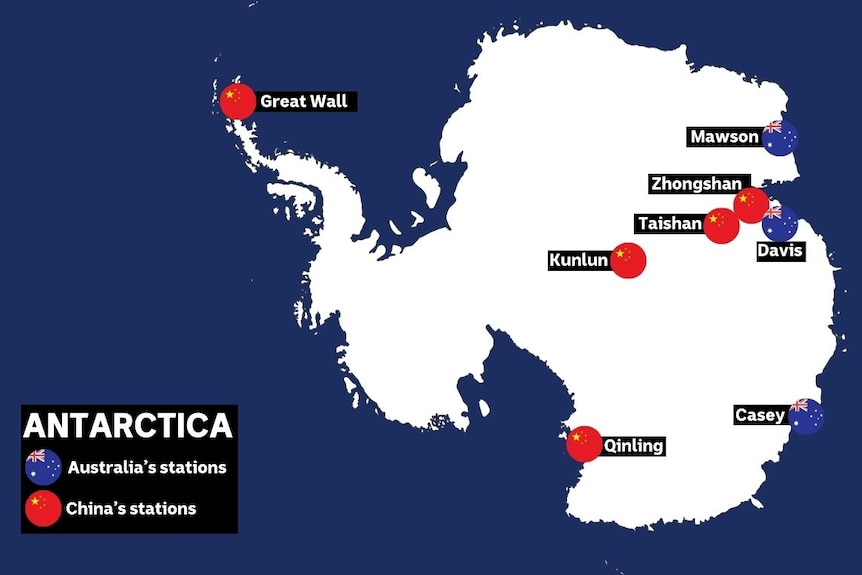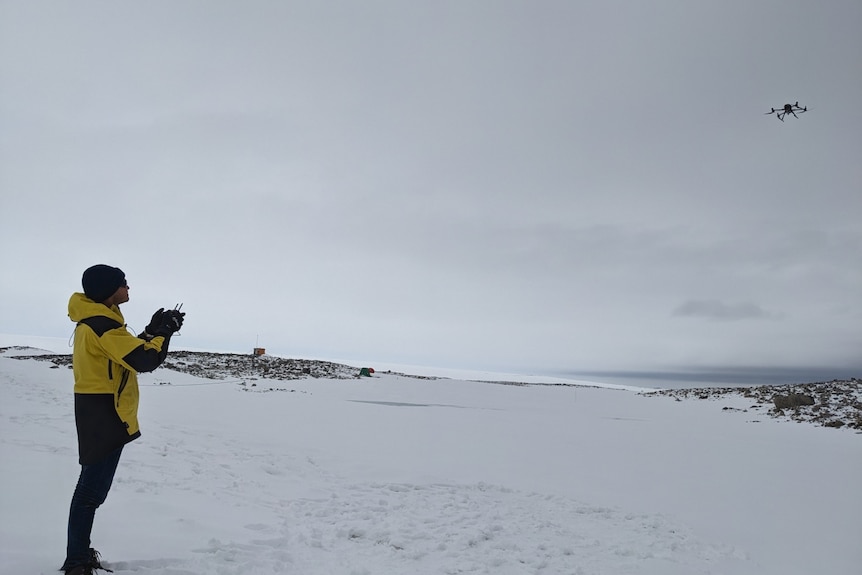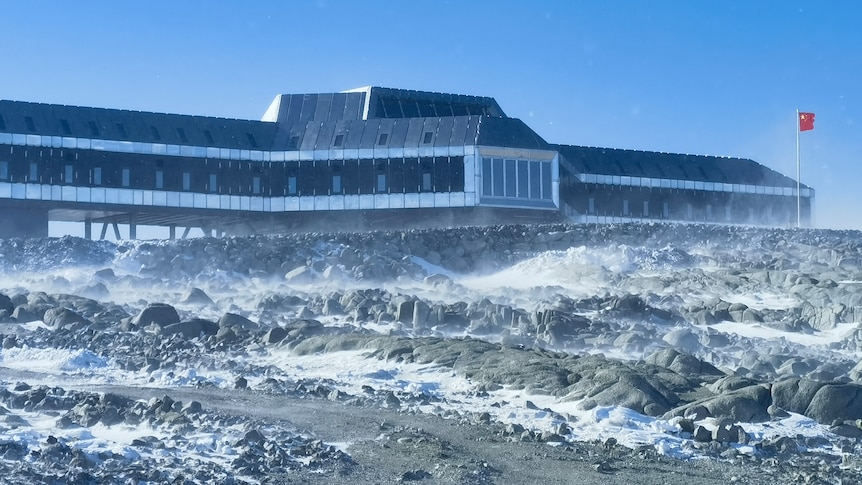China’s recent inauguration of its fifth research station in Antarctica has raised concerns among analysts regarding potential security risks near Australia. The experts cautioned that China’s increasing involvement in Antarctica, coupled with Australia’s passivity and insufficient funding, could pave the way for Beijing to establish a stronger strategic foothold in the icy continent. The establishment of the new Qinling base is seen as a move that could enhance China’s surveillance capabilities and grant them greater control over transportation routes to exploit resources. Despite these apprehensions, a spokesperson from the Chinese Foreign Ministry affirmed that the purpose of the new station is to facilitate collaborative scientific research and cooperation among China and other nations, aiming to promote peace and sustainable development in the region.

The construction of China’s Qinling Station in Antarctica is underway as part of the 40th Antarctic scientific expedition team from China. According to Elizabeth Buchanan from the Australian National University’s National Security College, the Chinese government demonstrates exceptional long-term planning capabilities. Dr. Buchanan highlighted that China’s focus may currently be on collaborative international research at the station for the next two decades. However, she also mentioned the potential for the station to evolve into a strategic staging platform for military purposes in the future, emphasizing the importance of analyzing China’s presence in Antarctica and its implications for Australia.
Strategic Importance of Qinling Station’s Location
The location of Qinling station, operational throughout the year, holds significant strategic value due to its positioning in the ice-free Ross Sea.
Dr. Buchanan emphasized the advantage of an ice-free base, enabling personnel to access it year-round, enhancing its strategic significance.
China strategically places Qinling to expand its presence in the Antarctic region, asserting its influence over the landmass.
Moreover, the station’s location facilitates improved satellite launches, further enhancing its strategic importance.
Dr. Buchanan suggested that Australia missed an opportunity by not establishing a year-round airstrip at Qinling, proposing collaboration with India and other nations.
Additionally, Beijing’s new Qinling base overlooks the Pacific arc, offering unobstructed access without any choke points.

China’s most recent addition to Antarctica’s operational stations is Qinling, as reported by ABC News’ Erwin Renaldi. Vessels navigating through the Panama and Suez Canal are encountering obstacles due to decreasing water levels attributed to drought worsened by climate change. Consequently, the canals have had to reduce the maximum depth allowance for ships, resulting in a decline in maritime traffic. The turbulent Drake Passage, situated between South America and China’s Great Wall station in Antarctica, could emerge as a more favored alternative route. Dr. Buchanan highlighted China’s decade-long efforts in constructing infrastructure in Chile and parts of Argentina, granting them control over the passage. She expressed concerns that China might impede the Drake Passage through various means, such as making it challenging to navigate, regulating shipping, or deploying additional boats for monitoring and potential blockades. The presence and activities of China in Antarctica are under scrutiny, with an analysis of their involvement being conducted in Australia.
Concerns Regarding China’s Presence in Antarctica
Tony Press, the former head of the Australian Antarctic Division, expressed his views on the potential military implications of China’s activities in Antarctica. He emphasized that the establishment of the Qinling base by China should not significantly increase surveillance risks, as China already conducts surveillance operations in various global regions.
Press highlighted that China’s development of the Qinling station aligns with the core principles of the Antarctic Treaty, emphasizing peaceful use and non-militarization. Australia conducted an inspection of the station in 2020 to ensure compliance with these obligations.

Australian experts are urging the government to increase funding in Antarctica to match China’s significant investments in the region. According to Mr. Press, Australia’s insufficient investment in Antarctic science and logistics capabilities is concerning, especially the limited capacity to operate across all parts of Antarctica throughout the year. Inspections of stations to ensure compliance with the Antarctic Treaty can be carried out by any treaty party following a consultative meeting. Mr. Press suggested enhancing Australia’s capability for inspections to enhance mutual assurance.
In terms of security concerns for Australia, the Department of Foreign Affairs referred to the Antarctic Treaty, which prohibits the militarization of Antarctica. Signed during the Cold War in 1959 by 12 nations, the treaty designates Antarctica as a “natural reserve, devoted to peace and science.” Although Australia, an original signatory, claims 42% of the continent as its sovereign territory, this claim is only acknowledged by four other countries.
Research conducted by Professor Anne-Marie Brady from the University of Canterbury revealed instances where China did not disclose its use of military personnel in Antarctica, including deploying a logistics expert from the People’s Liberation Army to establish the BeiDou-2 global positioning system. China’s expansion of dual-use satellite receiving ground stations in Antarctica has enhanced the accuracy of its BeiDou navigation system, similar to GPS. These stations and China’s territorial ambitions could aid in preparing for precision missile strikes, targeting, and satellite communication.
Ms. Brady highlighted that China, along with Russia and the US, is advancing technology to create high-frequency electromagnetic pulses capable of disrupting or destroying enemy electronics. Beijing has dismissed Western media reports as exaggerating China’s activities in Antarctica. The Chinese embassy in Canberra has been contacted by the ABC for a response regarding these matters.
The Growing Influence of China in Antarctica
As the competition for marine resources in the South China Sea escalates, experts like Daniel Bray from La Trobe University suggest that China may extend its reach to Antarctica, particularly focusing on fishing activities. Bray highlights that China’s accessibility to Antarctic waters, including the abundant krill populations, presents a lucrative opportunity for the nation due to the essential role krill plays in ecosystems and medicine.
Recent reports indicate that China has significantly increased its krill fishing efforts in Antarctica, causing concern among conservationists and scientists who advocate for stricter regulations to protect the delicate Antarctic ecosystem.
Despite the environmental implications, discussions around monitoring and preventing overfishing face obstacles as countries are cautious not to upset China. According to Bray, nations are hesitant to confront China on these issues to avoid potential conflicts.
Dr. Buchanan emphasizes China’s strategic advantage in the Arctic and Antarctic regions, supported by its robust shipbuilding capabilities, including the production of Antarctic icebreakers. This strategic positioning could potentially allow China to dominate these regions, influencing international trade and commerce.
Experts warn that China’s expanding presence in Antarctica not only poses challenges related to resource exploitation but also raises concerns about future sovereignty disputes if the Antarctic Treaty collapses. The prospect of a mineral and resource scramble in the region could further complicate geopolitical dynamics.

Emperor penguins can be spotted gracefully navigating the sea ice on the Brunt Ice Shelf in Antarctica, as captured in a photo by the British Antarctic Survey’s Peter Fretwell. According to Mr. Bray, fresh water stands out as a significant but often underestimated resource in Antarctica, hinting at potential future conflicts over water resources. He emphasizes the fragility of the trust underpinning the treaty governing Antarctica, warning that its erosion could trigger territorial disputes, particularly in the region south of Australia. Dr. Buchanan highlights the vast wealth of resources present on the continent, including minerals, hydrocarbons, oil, gas, and a staggering 70% of the Earth’s freshwater reserves locked within Antarctica. He notes China’s strategic positioning in anticipation of long-term benefits from the continent’s resources, emphasizing the need for careful analysis of China’s presence in Antarctica and its implications for Australia.
Strengthening Our Presence in Antarctica
According to Dr. Buchanan, the Australian government is not giving due consideration to China’s increasing influence in Antarctica.
She expressed concerns that Australia is neglecting this issue, referring to the country as “asleep at the wheel.”
Dr. Buchanan highlighted the lack of monitoring capabilities in Canberra regarding China’s activities in the strategic region between the Indian and Pacific oceans, crucial for fishing.
To address these gaps, she urged the government to appoint a dedicated Antarctic ambassador, enhance the fleet of marine vessels, and develop Hobart as a key refuelling hub for large icebreakers.
While the former Morrison government pledged $804 million over a decade to strengthen Australia’s presence in Antarctica, budget constraints have led to challenges.
Last year, the Australian Antarctic Division faced financial pressures, resulting in the need to cut costs and potentially reduce staff positions.
Dr. Buchanan emphasized the inadequacy of relying solely on the RSV Nuyina, the new icebreaker supporting Australia’s research team in Antarctica.

Australia’s latest Antarctic icebreaker, the RSV Nuyina, set sail in 2018, as reported by Briege Whitehead. Despite this significant investment, Australia lacks the necessary monitoring capabilities to effectively track China’s activities in the region. According to Mr. Bray, China has been vocal about its desire for a fair share of resources in Antarctica. The DFAT spokesperson, while not directly addressing concerns about insufficient funding, emphasized Australia’s dedication to the Antarctic Treaty system. This commitment includes adhering to regulations on non-militarization, environmental preservation, and the promotion of scientific research. In light of China’s increasing presence and activities in Antarctica, Australia faces challenges in monitoring and managing the situation effectively. For more information on this topic, please visit our site 60time.com.



